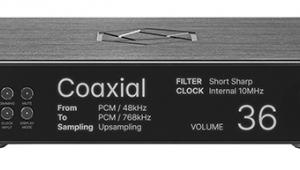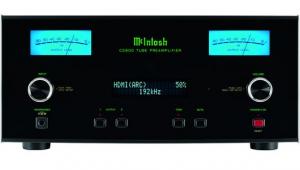dCS Lina System DAC/Headphone Amp Lab Reports
dCS Lina Network DAC
There are four key variables in the Lina DAC's operation that need exploring, starting with the 0.2V, 0.6V, 2V and 6V output modes in the device settings menu. The latter pair amount to 2.05V and 5.91V, offering A-wtd S/N ratios of 109.1dB and 117.0dB, respectively, all from a usefully low 1.0ohm balanced source impedance. There's a little extra stress on the output at 6V so THD is just fractionally higher here at 0.0001-0.00025% [see Graph 1, below] vs. 0.00009-0.00017% at 2V output (all re. 0dBFs, 20Hz-20kHz), but this is of academic interest only. Distortion falls to a minimum of 0.00003% over the top 20dB of its dynamic range – lower than achieved in the dCS Bartók [HFN May '19] and jitter [see Graph 2] remains super-low at ~20psec.
Two digital filters come with the DXD upsampling mode in the processing menu, 'F1' being a steep roll-off linear phase type that offers a fine 123dB stopband rejection and very flat response of ±0.01dB/20Hz-20kHz with 48kHz media, extending to –0.1dB/40kHz with 96kHz files before cutting off slightly early to reach –22dB/45kHz. 'F2' is a slow roll-off linear phase filter with reduced time domain distortion (ringing) but also a reduced –7.3dB stopband rejection and increased aliasing IMD. It looks to be equivalent to 'Filter 4' in the dCS Bartók where the response also rolls away more 'softly' to –3dB/36kHz and –10.4dB/45kHz (96kHz media). With DSD64 resampling, the swell of ultrasonic requantisation noise is 'managed' in the Lina by four alternative filters, F1 to F4. These are all linear phase filters applied before DSD conversion with –3dB limits set at 78kHz, 68kHz, 64kHz and 28kHz, respectively. The impact of DSD resampling is easily illustrated by the 96kHz jitter spectrum [red trace, Graph 2]. PM

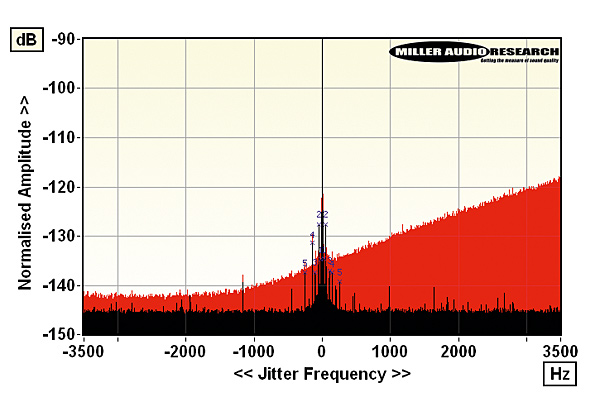
| Maximum output level / Impedance | 5.89Vrms / ohm (XLR out) |
| A-wtd S/N ratio (USB / Network) | 117.0dB / 117.1dB |
| Distortion (1kHz, 0dBFs/–30dBFs) | 0.00011% / 0.00013% |
| Distortion & Noise (20kHz, 0dBFs/–30dBFs) | 0.00025% / 0.00045% |
| Freq. resp. (20Hz-20kHz/45kHz/90kHz) | +0.0 to –0.0dB/–0.dB/+0.dB |
| Digital jitter (48kHz / 96kHz) | 21psec / 10psec |
| Resolution (1kHz @ –100dBFs/–110dBFs) | ±0.1dB / ±0.2dB |
| Power consumption | 22W (1W standby) |
| Dimensions (WHD) / Weight | 360x320x530mm / 9kg |
dCS Lina Headphone Amp
While the Lina DAC clearly inherits a deal of technology from the Bartók [HFN May '19], the Lina Headphone Amplifier is substantially more capable than the Bartók's integrated Class A preamp. There is some commonality, including the usefully low ~0.7ohm single-ended output impedance, but this is a function of good design practice as much as shared topology. Either way, it ensures there's a minimal 0.16dB signal loss into a 32ohm headphone load with a similar resilience over the system (amp/headphone) frequency response. The Headphone Amplifier's native response is almost unaffected by loading, running flat to within a tight ±0.1dB (20Hz-20kHz), falling slightly thereafter to –2dB/100kHz, while the residual noise is low at –90dBV and the A-wtd S/N a solid 96.2dB (re. 0dBV) via the SE output.
Distortion is influenced by loading, however, from a mere 0.00007-0.0005% (20Hz-20kHz) into high impedance loads to a slightly higher (but not 'high') 0.0003-0.004% at 10mW/32ohm via the SE output [red trace, Graph 2 below]. Two levels of gain are offered, amounting to +0.6dB (Low) and +11dB (High) via the standard XLR input. Input headroom is in excess of 12V, but the gain settings do influence the Lina's maximum output which is 760mW/32ohm in 'Low' and 1850mW/32ohm (1.85W) in the 'High' setting. Maximum output into high 600ohm headphones is 110mW while the complementary power amp has sufficient current to support a huge 5.4W into very low 8ohm loads [see Graph 1]. This Graph also confirms the steady increase in distortion when driving lower loads from 0.0002%/10mW/600ohm to 0.0015%/10mW/32ohm and 0.015%/10mW/8ohm [blue, black, red traces, respectively], though these figures are still well below that of a typical headphone. PM
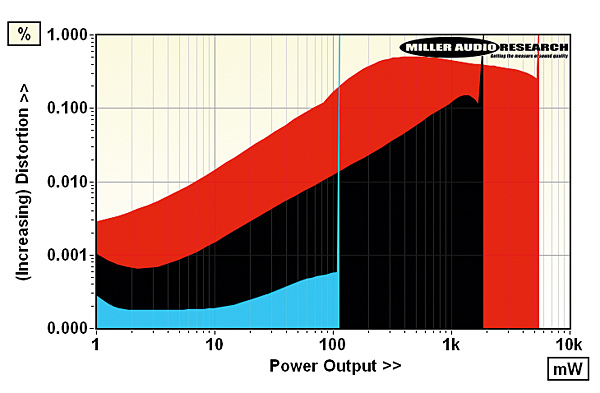
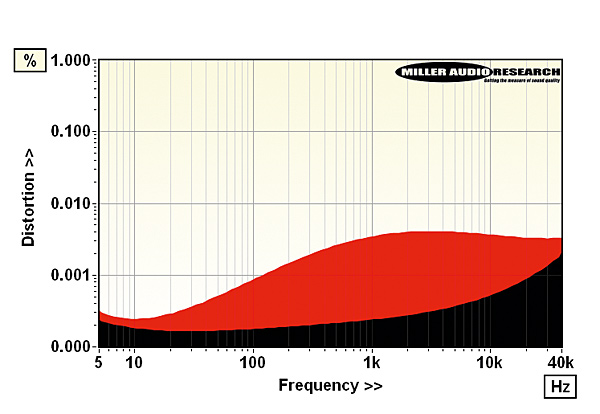
| Maximum output (<1% THD) / Gain(s) | 8.4V (SE) / +0.6dB / +11dB |
| Power output (<1% THD, 600/32/8ohm) | 110mW / 1850mW / 5400mW |
| Output Impedance (20Hz-20kHz) | 650-730mohm |
| A-wtd S/N ratio (re. 0dBV/32ohm) | 96.2dB / 95.9dB |
| Distortion (20Hz-20kHz, 0dBV) | 0.00007–0.0005% |
| Distortion (20Hz-20kHz, 10mW/32ohm) | 0.0003–0.004% |
| Freq. resp. (20Hz-20kHz/100kHz) | +0.0 to –0.1dB/–1.95dB |
| Power consumption | 8W (1W standby) |
| Dimensions (WHD) / Weight | 360x320x530mm / 9kg |
| Prices | £11,750 (Network DAC), £6750 (Clock), £8400 (Headphone Amp) |



